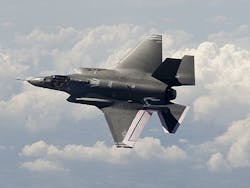Lockheed Martin tools-up to build 240 more F-35 fighter-bomber jet aircraft in $1.4 billion deal
PATUXENT RIVER NAS, Md. – U.S. Navy aviation authorities are asking Lockheed Martin Corp. to prepare for building another 240 F-35fighter-bomberjet aircraft for U.S. and foreign military forces under terms of a $1.4 billion contract announced Friday.
Officials of the U.S. Naval Air Systems Command at Patuxent River Naval Air Station, Md. -- the organization handling F-35 aviation technology procurement for all military forces -- are asking the Lockheed Martin Aeronautics segment in Fort Worth, Texas, for long-lead time materials, parts, components for future F-35 Lightning II combat jets.
Long-lead items involve system components that require the longest time to build, which could delay overall system production if money isn't allocated for production early in the process.
The F-35 with its advanced avionics is a fifth-generation single-seat, single-engine, all-weather stealth multirole jet fighter-bomber designed to perform ground attack, aerial reconnaissance, and air defense missions. It is one of the most advanced combat jets in the world.
The contract calls for Lockheed Martin to provide long-lead items for 130 low-rate initial production Lot 12 F-35s for the U.S. Air Force, Navy, Marine Corps, foreign militaries, as well as long-lead items for 110 Lots 13 and 14 F-35s for foreign militaries.
Related: F-35 combat jet: only time will tell if current problems will become long-term deficiencies
The F-35 is designed to replace U.S. F-16, A-10, F/A-18, and AV-8B tactical fighter and attack aircraft. Lockheed Martin has been developing the F-35 since 2001.
story continues below
The single-seat F-35 military jet is 50.5 feet long, has 35-foot wingspan, and is 14 feet tall. It has one Pratt & Whitney F135 afterburning turbofan engine that can produce as much as 43,100 pounds of thrust.
The aircraft can fly as fast as Mach 1.6, can fly as high as 50,000 feet, and has a range of 1,200 miles. It has one 25-millimeter Gatling gun and can carry a variety of advanced air-to-air missiles, air-to-ground missiles, smart bombs, and conventional bombs.
The F-35's avionics includes the Northrop Grumman AN/APG-81 AESA radar; Lockheed Martin AAQ-40 electro-optical targeting system (EOTS); Northrop Grumman AN/AAQ-37 distributed aperture system (DAS) missile warning system; BAE Systems AN/ASQ-239 electronic warfare (EW) suite; and Northrop Grumman AN/ASQ-242 communications and navigation system.
The plane's navigation and communications include the Harris Corp. Multifunction Advanced Data Link (MADL); Link 16 data link; single-channel ground and airborne radio system (SINCGARS); IFF interrogator and transponder; HAVE QUICK radio; AM, VHF, UHF AM, and UHF FM radio systems; GUARD survival radio; radar altimeter; tactical air navigation (TACAN); instrument landing system for conventional runways and aircraft carriers; the Joint Precision Approach and Landing System (JPALS); and the TADIL-J tactical digital information link with Joint-Variable-Message-Format (JVMF) communications.
Related: F-35 jet fighters to take integrated avionics to a whole new level
F-35 pilots wear a helmet-mounted display that enables them simply to look at a target to shoot weapons, rather than pointing the entire aircraft at the target. The orientation of the pilot's head provides missile seeker heads with targeting information.
The combat aircraft -- one of the most expensive military weapon systems in history -- is designed to perform ground attack, aerial reconnaissance, and air defense missions. Last July the first squadron was declared ready for deployment. U.S. military leaders say they plan to buy 2,457 aircraft.
The F-35 variants are intended to provide the bulk of the manned tactical air power of the U.S. Air Force, Navy, and Marine Corps. Deliveries of the F-35 for the U.S. military are scheduled to be completed in 2037.
On this contract Lockheed Martin and its partners will do the work in Fort Worth, Texas; El Segundo, Calif.; Warton, England; Orlando, Fla.; Nashua, N.H.; Nagoya, Japan; and in Baltimore, and should be finished by December 2018.
For more information contact Lockheed Martin online at www.f35.com, or Naval Air Systems Command at www.navair.navy.mil.
Learn more: search the Aerospace & Defense Buyer's Guide for companies, new products, press releases, and videos

